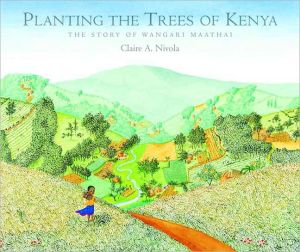Wangari's Trees of Peace: A True Story from Africa
As a young girl growing up in Kenya, Wangari was surrounded by trees. But years later when she returns home, she is shocked to see whole forests being cut down, and she knows that soon all the trees will be destroyed. So Wangari decides to do something—and starts by planting nine seedlings in her own backyard. And as they grow, so do her plans. . . .\ This true story of Wangari Maathai, environmentalist and winner of the Nobel Peace Prize,...
Search in google:
A picture book based on the true story of Wangari Maathai, an environmental and political activist in Kenya and winner of the Nobel Peace Prize in 2004The New York Times - Simon RodbergWangari's Trees of Peace strikes the balance between fact and child-friendliness. With blocky illustrations and bright colors, Maathai is treated as a friendly icon rather than a subject of realism. (The boat to college in America steams directly from giraffe to Statue of Liberty.) As a child Wangari harvests sweet potatoes with her mother, and after college she gets her knees dirty with first seedlings of her own; she's a role model who makes gardening look like serious, if back-aching, fun. This is a heroine children can relate to.
\ Simon RodbergWangari's Trees of Peace strikes the balance between fact and child-friendliness. With blocky illustrations and bright colors, Maathai is treated as a friendly icon rather than a subject of realism. (The boat to college in America steams directly from giraffe to Statue of Liberty.) As a child Wangari harvests sweet potatoes with her mother, and after college she gets her knees dirty with first seedlings of her own; she's a role model who makes gardening look like serious, if back-aching, fun. This is a heroine children can relate to.\ —The New York Times\ \ \ \ \ Publishers WeeklyWangari Maathai, the 2004 Nobel Peace Prize winner whose Green Belt Movement has planted 30 million trees in Kenya, is the subject of Winter's (The Librarian of Basra) eloquent picture biography. Much like Claire Nivola's recent Planting the Trees of Kenya, this work, for a slightly younger audience, introduces Wangari as a child, "liv[ing] under an umbrella of green trees in the shadow of Mount Kenya." The tightly focused text moves quickly without sacrificing impact. Wangari earns a scholarship to study in the U.S., and when she returns after six years, she's stunned-setting down her luggage in a veritable wasteland, extending her palms as if imploring someone to answer her unspoken questions: "What has happened?... Where are the trees? "She plants seedlings in her own backyard-a small start that eventually inspires thousands of others (and, perhaps, the reader) to emulate her. Winter's images appear in framed, same-size squares on each page, creating a flat, frieze-like effect that pays off as Wangari's movement grows and the activities within each frame multiply-a powerful demonstration of Wangari's work. Ages 3-7. (Sept.)\ Copyright © Reed Business Information, a division of Reed Elsevier Inc. All rights reserved.\ \ \ School Library JournalK-Gr 4\ This delightful picture-book biography of the environmentalist has engaging illustrations and accessible, succinct prose. When Wangari Maathai was growing up in Kenya, the land was covered with trees. But on returning to her homeland from America, where she was educated on scholarship, she discovered a hot, dry, barren land, stripped of the trees she loved as a child. Starting in her own backyard, Maathai planted trees and encouraged other women to do the same. More than 30 million trees have since been planted by the members of her Green Belt Movement. Maathai was awarded the Nobel Prize in 2004 in recognition of her work. The acrylic illustrations have a warm folk-art influence. The pictures are both literal and symbolic, and framed in complementary lines of color. An author's note and a quote from Maathai are included. This book would be a superb choice for read-alouds or assignments.-Melissa Christy Buron, Epps Island Elementary, Houston, TX\ \ \ \ \ \ Kirkus ReviewsNobel Peace Prize-winner Wangari Maathai's work to reverse the deforestation of Kenya garners Winter's signature treatment: a spare, reverential text and stylized, reductionist paintings. The present-tense narration posits Wangari's thoughts and inserts unattributed quotations: "Will all of Kenya become a desert? she wonders as her tears fall." "The government men laugh. 'Women can't do this,' they say." Wangari is imprisoned for her actions, but while she is textually and visually depicted in jail and then on the next spread free within the treed landscape, the text makes no mention of her release. Possibly most egregious in this day and age is the image of Wangari standing within an undifferentiated Africa while to the north, Europe is depicted with rudimentary national boundaries. While the effort of producing an intelligible picture-book biography for young children inevitably involves the selection of just a small number of details, this sere distillation is arguably more inspiring story than biography. For a contrast in depth and documentation, see Claire A. Nivola's recent Planting the Trees of Kenya: The Story of Wangari Maathai (2008). (author's note) (Picture book/biography. 4-7)\ \







